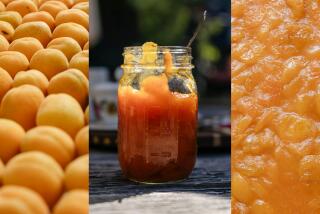Tasty Pineapple Jams
- Share via
Whenever the winter doldrums are upon me in the kitchen I tend to think about making jam, and all the fruits I took for granted six months before.
I now have the energy and right weather conditions to put up a couple of dozen jars, but there are no cherries, berries, peaches or plums. The fruits all are blooming in New Zealand or Chile, waiting to be air-shipped to American gourmet grocers, but since neither my pocketbook nor principles stretch sufficiently to permit the indulgence, the out-of-season fruit is definitely not in my jam pot. However, one tropical fruit--pineapple--is.
Grown mainly in Hawaii, Puerto Rico and Central America, pineapple is available fresh at supermarkets year-round, but its peak season from the standpoint of flavor and economy is late February to early June.
Pineapple is a fruit with no starch reserve and must be picked ripe. Unripe pineapple will not sweeten after picking, but will lose some of its acid present at harvest. Experts claim the best way to test a pineapple for ripeness is to give the globe a gentle thump. If it sounds solid rather than hollow and exudes a slight perfume, you’re in business.
Pineapple is high in citric acid but relatively low in sugar so it needs heavy reinforcement in terms of sweetening a jam pot. This fruit also contains protease, an enzyme that breaks down protein, which explains an old childhood puzzle of mine: namely, why raw pineapple chunks always deterred bowls of fruit-flavored gelatin from firming up. Cooking pineapple is imperative when making jelly and jam, unless you prefer yours on the liquid side. What follows is a mixed bouquet for the pantry shelf. The jam makes a wonderful coating for baked ham, and the recipe for chutney will make any curry lover proud. HOT CHILE-PINEAPPLE JAM
2 small pineapples, diced
Peel of 1 orange, finely slivered
Pulp of 1 orange, seeded and chopped
Peel of 1 lemon, finely slivered
Pulp of 1 lemon, seeded and chopped
4 cups sugar
1 large sweet red pepper, cored, seeded and finely chopped
1 large yellow pepper, cored, seeded and finely chopped
1 1/2 to 2 tablespoons finely chopped green chiles
Combine pineapples, orange peel, orange pulp, lemon peel, lemon pulp and sugar in large pot. Heat to boiling. Reduce heat and simmer until thickened, about 45 to 50 minutes. Stir in peppers and chiles. Cook 3 minutes. Pour into sterilized jars and seal. Makes about 5 pints.
Louisiana natives have wonderful dishes that they make with pineapple. My favorite is the relish that follows. It’s an old recipe but a good one and worth all the time and trouble. More importantly, this chutney improves with age. For a treat, serve a dab alongside a platter of fried fish or shrimp, the way they do in New Orleans. NEW ORLEANS-STYLE PINEAPPLE CHUTNEY
1 small pineapple, peeled, cored and cut into 1-1/4 inch chunks (about 2 cups)
2 pears, peeled, cored and sliced
1 small mango
Pulp from 1/2 large orange
1/4 cup orange juice
3/4 cup dark brown sugar, packed
4 ounces dried figs, cut into pieces
1/4 cup raisins
4 dried apricots
Peel from 1/2 lemon, finely slivered
Peel from 1/2 orange, finely slivered
1 1/2 teaspoons candied ginger, cut into strips
1/2 teaspoon ground mace
1 cinnamon stick broken in half
3/4 cup walnuts
1/2 cup grated coconut
1 1/2 teaspoons vinegar
3/4 cup dark rum
Combine pineapple, pears, mango, orange pulp, orange juice and brown sugar in medium saucepan. Bring to boil, reduce heat and simmer 5 minutes. Add figs, raisins, apricots, orange and lemon peels, ginger, mace and cinnamon. Simmer 30 minutes.
Add walnuts, coconut and vinegar. Continue to cook until all fruit is tender. Add rum. Bring to just under boil. Remove from heat. Spoon into hot sterilized jars and seal. Store in cool place several months. Or cool and place in any covered glass container and keep in refrigerator 2 to 3 weeks. Makes about 4 pints.
More to Read
Eat your way across L.A.
Get our weekly Tasting Notes newsletter for reviews, news and more.
You may occasionally receive promotional content from the Los Angeles Times.










